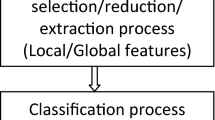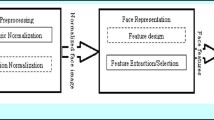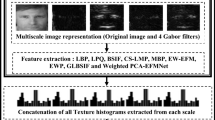Abstract
Face recognition is one of the challenging problems which suffer from practical issues like the pose, expression, illumination changes, and aging. Plastic surgery is one among the issues that pose great difficulty in recognizing the faces. The literature has been reported with traditional features and classifiers for recognizing the faces after plastic surgery. This paper presents an adaptive feature descriptor and advanced classifier for plastic surgery face recognition. According to the proposed feature descriptor, firstly an adaptive Gaussian transfer function is determined to perform Adaptive Gaussian Filtering (AGF) for images. Secondly, Adaptive Entropy-based SIFT (AEV-SIFT) features are extracted from the filtered images. Unlike traditional SIFT, the proposed AEV-SIFT extracts the key points based on the entropy of the volume information of the pixel intensities. This provides the least effect on uncertain variations in the face because the entropy is the higher order statistical feature. Further, the classification is performed with variations. In the first variation, support vector machine (SVM) is used as a classifier, whereas the second variation exploits the Deep Learning Network (DLN) for recognizing the faces based on the AEV-SIFT features. The proposed method classifies the plastic surgery face images with the accuracy of 80.15%, sensitivity of 19.75% and specificity of 95%, which are obviously better than the traditional features such as SIFT, V-SIFT, and Principal Component Analysis (PCA).
Similar content being viewed by others
References
A. K. Sao and B. Yegnanarayana, “Face verification using template matching,” IEEE Trans. Inf. Forensics Secur. 2 (3), 636–641 (2007).
W. R. Schwartz, H. Guo, J. Choi, and L. S. Davis, “Face identification using large feature sets,” IEEE Trans. Image Process. 21 (4), 2245–2255 (2012).
M. A. Turk and A. P. Pentland, “Face recognition using eigenfaces,” in Proc. 1991 IEEE Computer Society Conference on Computer Vision and Pattern Recognition (CVPR) (Maui, HI, 1991), pp. 586–591.
J. Ruiz–del–Solar and P. Navarrete, “Eigenspace–based face recognition: A comparative study of different approaches,” IEEE Trans. Syst. Man Cybern., Part C 35 (3), 315–325 (2005).
S. Lawrence, C. L. Giles, A. C. Tsoi, and A. D. Back, “Face recognition: a convolutional neural–network approach,” IEEE Trans. Neural Networks 8 (1), 98–113 (1997).
X. He, S. Yan, Y. Hu, P. Niyogi, and H.–J. Zhang, “Face recognition using Laplacianfaces,” IEEE Trans. Pattern Anal. Mach. Intell. 27 (3), 328–340 (2005).
T. Inan and U. Halici, “3D face recognition with local shape descriptors,” IEEE Trans. Inf. Forensics Secur. 7 (2), 577–587 (2012).
Z. Lu, X. Jiang, and A. C. Kot, “A color channel fusion approach for face recognition,” IEEE Signal Process. Lett. 22 (11), 1839–1843 (2015).
Y. Xu, X. Fang, X. Li, J. Yang, J. You, H. Liu, and S. Teng, “Data uncertainty in face recognition,” IEEE Trans. Cybern. 44 (10), 1950–1961 (2014).
A. K. Jain, B. Klare, and U. Park, “Face recognition: Some challenges in forensics,” in Face and Gesture 2011: Proc. 2011 IEEE Int. Conf. on Automatic Face and Gesture Recognition and Workshops (FG 2011) (Santa Barbara, CA, 2011), pp. 726–733.
C. C. Chude–Olisah, G. B. Sulong, U. A. K. Chude–Okonkwo, and S. Z. M. Hashim, “Edge–based representation and recognition for surgically altered face images,” in Proc. 2013 7th Int. Conf. on Signal Processing and Communication Systems (ICSPCS) (Carrara, Australia, 2013), pp. 1–7.
N. Kohli, D. Yadav, and A. Noore, “Multiple projective dictionary learning to detect plastic surgery for face verification,” IEEE Access 3, 2572–2580 (2015).
P. Sharma, R. N. Yadav, and K. V. Arya, “Pose–invariant face recognition using curvelet neural network,” IET Biometrics 3 (3), 128–138 (2014).
S.–H. Lee, D.–J. Kim, and J.–H. Cho, “Illumination–robust face recognition system based on differential components,” IEEE Trans. Consum. Electron. 58 (3), 963–970 (2012).
W. W. W. Zou and P. C. Yuen, “Very low resolution face recognition problem,” IEEE Trans. Image Process. 21 (1), 327–340 (2012).
U. Park, Y. Tong, and A. K. Jain, “Age–invariant face recognition,” IEEE Trans. Pattern Anal. Mach. Intell. 32 (5), 947–954 (2010).
S. P. Mudunuri and S. Biswas, “Low resolution face recognition across variations in pose and illumination,” IEEE Trans. Pattern Anal. Mach. Intell. 38 (5), 1034–1040 (2016).
R. Singh, M. Vatsa, and A. Noore, “Effect of plastic surgery on face recognition: A preliminary study,” in Proc. 2009 IEEE Computer Society Conference on Computer Vision and Pattern Recognition Workshops (CVPRW) (Miami, FL, 2009), pp. 72–77.
R. Singh, M. Vatsa, H. S. Bhatt, S. Bharadwaj, A. Noore, and S. S. Nooreyezdan, “Plastic surgery: A new dimension to face recognition,” IEEE Trans. Inf. Forensics Secur. 5 (3), 441–448 (2010).
X. Liu, S. Shan, and X. Chen, “Face recognition after plastic surgery: A comprehensive study,” in Computer Vision–ACCV 2012, Proc. 11th Asian Conf. on Computer Vision, Part II, Ed. by K. M. Lee, Y. Matsushita, J. M. Rehg, and Z. Hu, Lecture Notes in Computer Science (Springer, Berlin, Heidelberg, 2012), Vol. 7725, pp. 565–576.
M. De Marsico, M. Nappi, D. Riccio, and H. Wechsler, “Robust face recognition after plastic surgery using local region analysis,” in Image Analysis and Recognition, Proc. 8th Int. Conf. ICIAR 2011, Part II, Ed. by M. Kamel and A. Campilho, Lecture Notes in Computer Science (Springer, Berlin, Heidelberg, 2011), Vol. 6754, pp. 191–200.
N. S. Lakshmiprabha and S. Majumder, “Face recognition system invariant to plastic surgery,” in Proc. 2012 12th Int. Conf. on Intelligent Systems Design and Applications (ISDA) (Kochi, India, 2012), pp. 258–263.
A. R. Gulhane, S. A. Ladhake, and S. B. Kasturiwala, “A review on surgically altered face images recognition using multimodal bio–metric features,” in Proc. 2015 2nd Int. Conf. on Electronics and Communication Systems (ICECS) (Coimbatore, India, 2015), pp. 1168–1171.
C. Chude–Olisah, G. Sulong, U. A. K. Chude–Okonkwo, and S. Z. M. Hashim, “Face recognition via edge–based Gabor feature representation for plastic surgery–altered images,” EURASIP J. Adv. Signal Process. 2014 (102), 1–15 (2014).
H. Ouanan and M. Ouanan, “Gabor–HOG features based face recognition scheme,” TELKOMNIKA Indones. J. Electr. Eng. 15 (2), 331–335 (2015).
M. I. Ouloul, Z. Moutakki, K. Afdel, and A. Amghar, “An efficient face recognition using SIFT descriptor in RGB–D images,” Int. J. Electr. Comput. Eng. (IJECE) 5 (6), 1227–1233 (2015).
H. S. Bhatt, S. Bharadwaj, R. Singh, and M. Vatsa, “Recognizing surgically altered face images using multiobjective evolutionary algorithm,” IEEE Trans. Inf. Forensics Secur. 8 (1), 89–100 (2013).
A. S. O. Ali, V. Sagayan, A. Malik, and A. Aziz, “Proposed face recognition system after plastic surgery,” IET Comput. Vision 10 (5), 342–348 (2016).
M. De Marsico, M. Nappi, D. Riccio, and H. Wechsler, “Robust face recognition after plastic surgery using region–based approaches,” Pattern Recogn. 48 (4), 1261–1276 (2015).
R. Tavoli, E. Kozegar, M. Shojafar, H. M., Soleimani and Z. Pooranian, “Weighted PCA for improving Document Image Retrieval System based on keyword spotting accuracy,” in Proc. 2013 36th Int. Conf. on Telecommunications and Signal Processing (TSP) (Rome, Italy, 2013), pp. 773–777.
D. Petkovic, S. Shamshirband, N. B. Anuar, A. Q. Md. Sabri, Z. B. A. Rahman, and N. D. Pavlovic, “Input displacement neuro–fuzzy control and object recognition by compliant multi–fingered passively adaptive robotic gripper,” J. Intell. Robot. Syst. 82 (2), 177–187 (2016).
S. Agaian, M. Madhukar, and A. T. Chronopoulos, “A new acute leukaemia–automated classification system,” Comput. Methods Biomech. Biomed. Eng.: Imaging and Visualization 6 (3), 303–314 (2018).
M. Madhukar, S. Agaian, and A. T. Chronopoulos, “Deterministic model for Acute MyelogeNous Leukemia classification,” in Proc. 2012 IEEE Int. Conf. on Systems, Man and Cybernetics (SMC) (Seoul, South Korea, 2012), pp. 433–438.
D. S. S. Al–Azzawy, “Eigenface and SIFT for gender classification,” J. Wassit Sci. Med. 5 (1), 60–76 (2012).
C. Geng and X. Jiang, “Face Recognition Using SIFT Features,” in Proc. 2009 16th IEEE Int. Conf. on Image Processing (ICIP) (Cairo, Egypt, 2009), pp. 3313–3316.
Author information
Authors and Affiliations
Corresponding author
Additional information
The article is published in the original.
Archana H. Sable, she received ME degree in computer Science and engineering from M.G.M’s College of Engg., SRTM University, Nanded. Her research interests are Image processing, Pattern recognizing and Computer vision. She is doing PhD (Thesis) in Computer Engg. from SRTM University, Nanded.
Sanjay N. Talbar received his B.E and M.E degrees from SGGS Institute of Technology, Nanded, India in 1985 and 1990, respectively. He obtained his PhD from SRTM University, Nanded, India in 2000. He received the “Young Scientist Award” by URSI, Italy in 2003. He had Collaborative research programme at Cardiff University Wales, UK. Presently he is working as Professor and Head, Department of Electronics and Telecommunication Engg., SGGS Institute of Engineering and Technology Nanded, India. He has published 50 journal papers, 10 books, and more than 125 papers in referred National as well as International Conferences. His research interests includes Image processing, Medical Image processing, Multimedia Computing and Embedded System Design. He is a member of IEEE, IET, IETE, AMPI, ISTE, and worked on many prestigious committees in academic field of India.
Haricharan Amarsing Dhirbasi, he received B.Sc (Mathematics), M.Sc (Mathematics), M. Phil. (Mathematics) from SRTM University, Nanded. He is SET (Mathematics) qualified. Hi’s research interests is in Study and application of Integral Transform in Image processing. He is doing PhD (Mathematics) from SRTM University, Nanded.
Rights and permissions
About this article
Cite this article
Sable, A.H., Talbar, S.N. An Adaptive Entropy Based Scale Invariant Face Recognition Face Altered by Plastic Surgery. Pattern Recognit. Image Anal. 28, 813–829 (2018). https://doi.org/10.1134/S1054661818040041
Received:
Published:
Issue Date:
DOI: https://doi.org/10.1134/S1054661818040041




